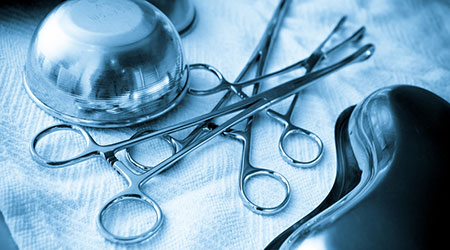The COVID-19 pandemic continues to reshape and challenge the patient and caregiver experience within acute and ambulatory healthcare settings. In many ways, the pandemic has become an accelerator or catalyst for change, forcing healthcare organizations to refocus or fast-track existing or new initiatives.
For instance, the pandemic has brought a new urgency to infection prevention, as healthcare organizations work to keep patients and staff safe, and as patients seek assurances that necessary precautions are being taken. Now is the perfect time to assess your current infection prevention efforts. In fact, there are steps that you can take in two key areas — instrument processing and contact tracing — that can help enhance your infection prevention program.
Standardize instrument processing
Instrument processing is a critical part of any infection prevention protocol. As antimicrobial resistance and "superbugs", as well as COVID-19, loom even larger in headlines, the need for consistent and effective instrument processing has never been more important.
Ideally, the instrument processing space within your facility should be a separate, discrete area designed specifically for instrument processing and sterilization. This separation allows you to more easily control and manage the process and help ensure safety and an efficient workflow. Instrument processing and sterilization should not share space with a laboratory or staff break area, or be located in the facility’s storage room.
Regardless of the size or shape of your instrument processing area, there are five critical steps, based on Centers for Disease Control and Prevention (CDC) guidelines, that should be a part of your instrument processing workflow design. Implementing these steps will help ensure a smooth dirty-to-clean design for the flow of instruments that will help contain contamination and maximize efficiency.
-
Receiving, Cleaning + Decontamination: Reusable instruments, supplies and equipment should be received, sorted, cleaned and decontaminated of both macroscopic and microscopic debris in this section of the processing section.
-
Preparation + Packaging: This section should contain a sink where cleaned instruments and other supplies can be rinsed and dried thoroughly, before being inspected, assembled into sets or trays, and wrapped or packaged for sterilization.
-
Sterilization: The sterilization section should be large enough to include the sterilizer and related supplies with adequate space for loading, unloading and cool down of instruments after sterilization.
-
Monitoring/Sterility Assurance: This section needs to be configured to support documentation and recording of the mechanical, chemical and/or biological monitoring used to help ensure the effectiveness of the sterilization process.
-
Storage: The storage section should be covered and contain adequate space for sterile and disposable items so they are not stored under sinks or in other locations where they might become wet or damaged.
Automate contact tracing
Due to its high transmission rates, COVID-19 has heightened the awareness of environmental exposures for both patients and healthcare organizations. This is putting greater strain on traditional manual contract tracing processes.
Real-time locating system (RTLS) technology can automate the labor-intensive process of contact tracing, thereby helping to increase the speed, effectiveness and accuracy of monitoring efforts. RTLS technology, which has been providing value in acute care for decades, makes capturing accurate workflow data possible, communicating in-the-moment patient and staff locations, wait times and staff interactions, as well as a vast amount of retrospective detail. It offers greater visibility, management of processes and orchestration of caregiver interactions.
Utilizing RTLS badges and sensors, the technology can automatically track and document patient and staff interactions. Caregivers can simply run a report that helps immediately identify with whom a patient diagnosed with an infectious disease came in contact, which areas of the facility were visited and what equipment was used. This allows caregivers to quickly notify, test and treat those who came into contact with the contagion, as well as support decontamination efforts.
Once implemented, RTLS technology can also help healthcare organizations and facilities eliminate the waiting room, increasingly seen as an additional step that can minimize exposure to contagions and simplify contact tracing efforts.
For instance, an RTLS-enabled self-rooming workflow design model allows patients to check in for their appointment and proceed directly to an exam room or diagnostic sub-waiting location either on their own or escorted by a staff member. Patients receive locator badges at check-in and staff use RTLS software to identify which rooms are clean and ready for a new patient. Upon the patient’s entry into the room, the RTLS technology automatically notifies the care team of their arrival.
When patients and staff feel safe, comfortable and empowered, better outcomes are more attainable. The effectiveness of your infection prevention program is key to this. By standardizing your instrument processing procedures with design that allows you to better follow CDC guidelines and automate contact tracing to include eliminating waiting areas, you can strengthen your infection prevention program, the safety of your patents and staff and the delivery of care.
Kurt Forsthoefel is the Director of Medical Marketing, Midmark.

 UF Health Hospitals Rely on Green Globes to Realize Their Full Potential
UF Health Hospitals Rely on Green Globes to Realize Their Full Potential How Healthcare Facilities Can Be Truly Disaster-Resilient
How Healthcare Facilities Can Be Truly Disaster-Resilient TriasMD Breaks Ground on DISC Surgery Center for San Fernando Valley
TriasMD Breaks Ground on DISC Surgery Center for San Fernando Valley Bigfork Valley Hospital Falls Victim to Data Breach
Bigfork Valley Hospital Falls Victim to Data Breach AI-Driven Facilities: Strategic Planning and Cost Management
AI-Driven Facilities: Strategic Planning and Cost Management